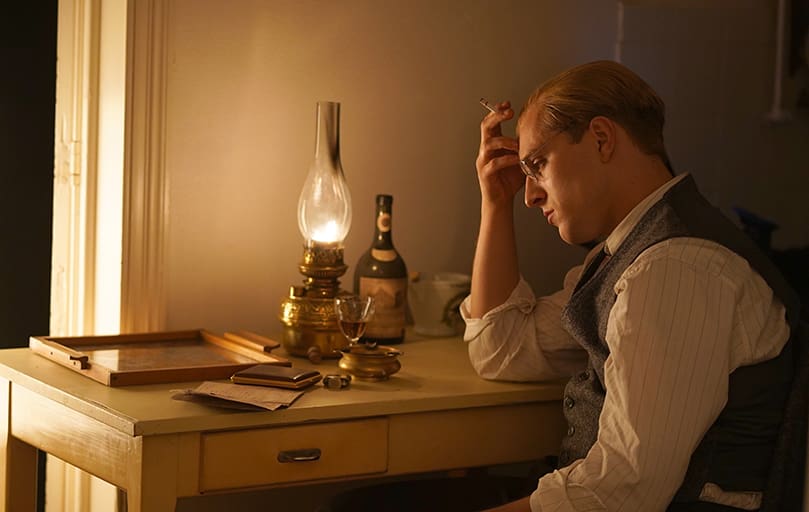 OSV News photo/Angel Films
OSV News photo/Angel Films‘Bonhoeffer: Pastor. Spy. Assassin.’ profiles well-known Christian martyr
By KURT JENSEN, OSV News | Published December 18, 2024
NEW YORK (OSV News)—In crafting the biopic “Bonhoeffer: Pastor. Spy. Assassin.” (Angel), writer-director Todd Komarnicki can be credited with being scrupulous about historical truth. Yet, despite the film’s provocative full title—which suggests that he had a lot of interesting material to mine from his subject’s life—there’s a ponderous tone to his profile.
Komarnicki’s is the latest in what have so far been a dozen documentaries about—and dramatizations of—the life of Rev. Dietrich Bonhoeffer, the German Lutheran theologian who is one of the best-known Christian martyrs of the 20th century. After two years of imprisonment, Bonhoeffer—an outspoken critic of the Nazi regime—was executed on April 9, 1945.
Bonhoeffer’s reputation as a scholar, however, does not rest on his heroic death. His 1937 volume “The Cost of Discipleship,” a study of the Sermon on the Mount, is renowned as a classic of modern theological writing.
In other works, Bonhoeffer criticized some aspects of the church’s role in history and even spoke of a “religionless Christianity,” a concept subsequently taken up by proponents of liberation theology as well as Marxist scholars. If Bonhoeffer’s thought was complex, so too were his personality and outlook.
Komarnicki draws on the similarly subtitled 2011 biography by Eric Metaxas, “Bonhoeffer: Pastor, Martyr, Prophet, Spy.” That book, in turn, hews closely to the first published exploration of Bonhoeffer’s career penned by his friend and colleague, Rev. Eberhard Bethge (1909-2000).
Eyewitness accounts of Bonhoeffer’s holiness might have been the basis for his canonization had he been a Catholic. But that was an idea Bethge scorned.
Speaking about Bonhoeffer to a reporter in 1970, Bethge said, “Americans make him a saint without seeing him as a man who had a dirty job to do.” Namely, plotting Hitler’s assassination and the overthrow of his tyrannical government.
“Yes, he is a modern saint,” Bethge continued. “But it has little to do with the old idea of sanctity and purity. He was a man of action whose sharp theological insights and Christian responsibility compelled him to act decisively in the real world of dirt, difficulty and danger.”
The primary weakness in Komarnicki’s depiction of Bonhoeffer is that, as played by Jonas Dassler, he comes across as a wholly unconflicted clerical commando, eager to take on his “dirty job.” This seemingly ignores the “peace ethic” to which Bonhoeffer was committed as well as his opposition to war in general, a stance he believed was directly commanded by God.
While such granularity may be lacking, this is still a reasonably informative survey of Bonhoeffer’s faith, ministry and role in the resistance. Viewers are also introduced to Bonhoeffer’s partnership with Rev. Martin Niemoller (August Diehl) with whom he helped to establish the Confessing Church—in opposition to the Nazi-compliant Reich Church.
Because he was from a prominent and well-connected family, Bonhoeffer was able to join the Abwehr, Germany’s counterintelligence agency. The ostensible reasoning was that his widespread international contacts would be of use to the organization. In fact, the Abwehr was a hotbed of anti-Nazi activity.
Bonhoeffer worked as a courier, sharing information about plans to do away with Hitler, until his arrest. In the aftermath of the July 20, 1944, attempt on the Fuehrer’s life, in which former Abwehr chief Admiral Wilhelm Canaris was implicated, several prisoners connected to the now-disbanded agency were condemned to death, Bonhoeffer included.
This is the context for the movie’s most poignant scene. On the evening before his execution, Bonhoeffer leads an ecumenical Communion service with a small group of other prisoners using crumbs of the stale bread on which they subsisted. Komarnicki’s staging draws a direct parallel with the Last Supper.
It was a Sunday, and Bonhoeffer was conducting the rite simply because that was his Sabbath custom—performed, at this moment, without despair and with firm trust in the reality of eternal life.
Bonhoeffer was not broken by his circumstances, nor did he bend. Sunday was for church.
Rating and Classification
The film contains mature themes, a hanging and several scenes of physical violence. The OSV News classification is A-III—adults. The Motion Picture Association rating is PG-13—parents strongly cautioned. Some material may be inappropriate for children under 13.